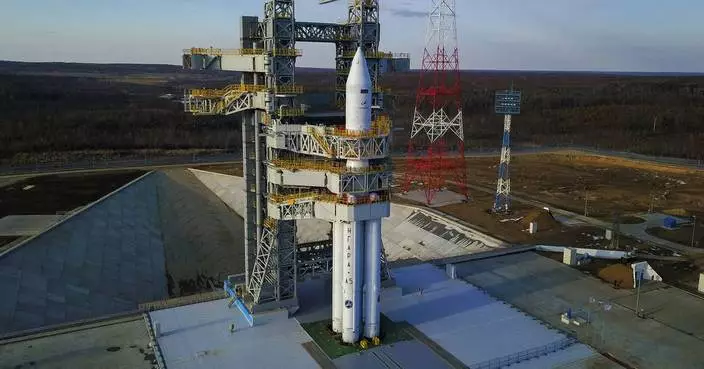A stash of frozen treats and other supplies rocketed toward the International Space Station on Sunday, this time from Virginia's cold eastern shore.
NASA's commercial shipper, Orbital ATK, launched the cargo ship just after sunrise from Wallops Island, aboard an unmanned Antares rocket.
Click to Gallery
A stash of frozen treats and other supplies rocketed toward the International Space Station on Sunday, this time from Virginia's cold eastern shore.
The rocket is carrying cargo to the International Space Station. (AP Photo/Steve Helber)
The Cygnus capsule should reach the orbiting lab Tuesday. It's loaded with 7,400 pounds of cargo, including sweet treats for the six station astronauts. There are frozen fruit bars, ice cream bars, ice cream sandwiches and cups of chocolate and vanilla ice cream — about 80 in all, according to NASA.
"Pizza and ice cream on the way!" NASA astronaut Joe Acaba tweeted following liftoff. "Eagerly awaiting the arrival."
Orbital ATK's Antares rocket sits on the 0A launch pad moments before a scheduled launch at the NASA Wallops Island flight facility in Wallops Island, Va., Saturday, Nov. 11, 2017. The launch of the rocket which is carrying cargo to the International Space Station was postponed due to aircraft in the area. (AP Photo/Steve Helber)
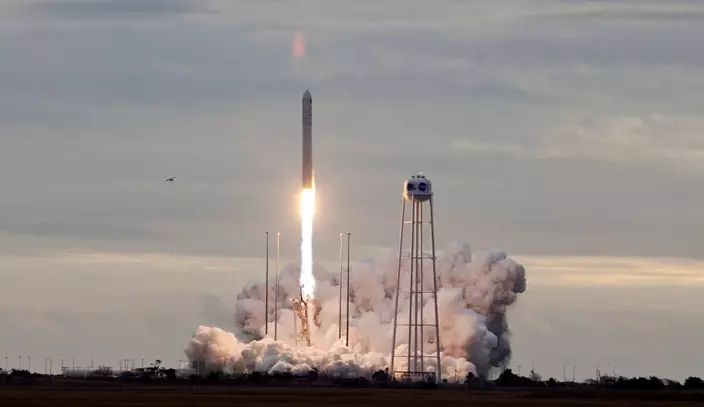
Orbital ATK's Antares rocket lifts off from Wallops Island, Va., Sunday, Nov. 12, 2017. The rocket is carrying cargo to the International Space Station. (AP Photo/Steve Helber)
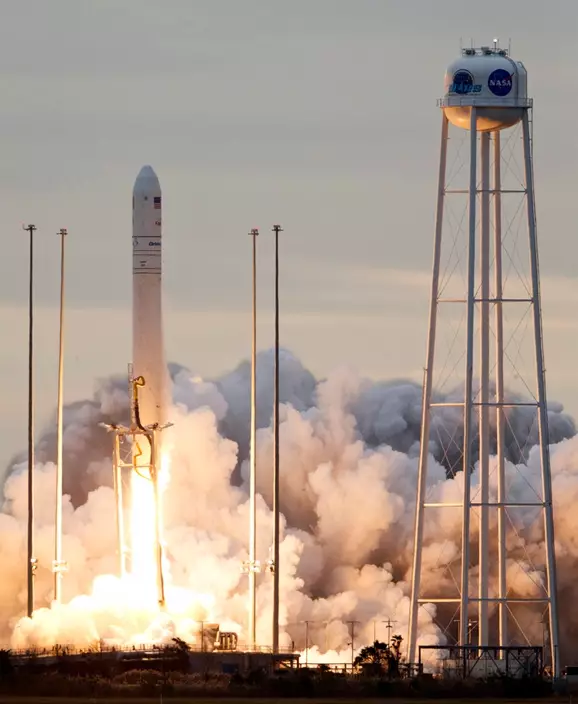
The rocket is carrying cargo to the International Space Station. (AP Photo/Steve Helber)
The Cygnus capsule should reach the orbiting lab Tuesday. It's loaded with 7,400 pounds of cargo, including sweet treats for the six station astronauts. There are frozen fruit bars, ice cream bars, ice cream sandwiches and cups of chocolate and vanilla ice cream — about 80 in all, according to NASA.
The crew expects pizza as well. Italian astronaut Paolo Nespoli has been craving pizza for months.
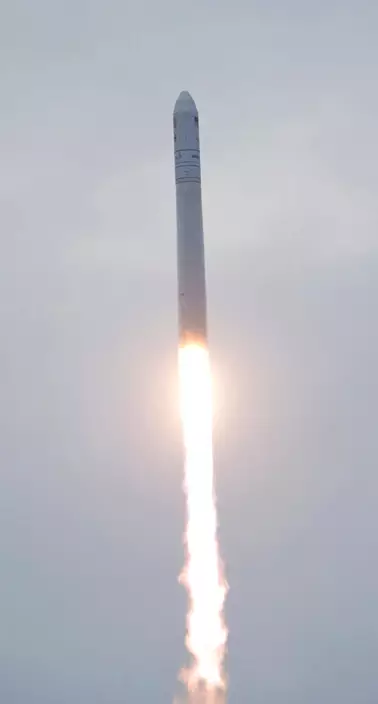
Orbital ATK's Antares rocket lifts off from NASA's Wallops Flight Facility in Wallops Island, Va., Sunday, Nov. 12, 2017. The rocket is carrying cargo to the International Space Station. (AP Photo/Steve Helber)
"Pizza and ice cream on the way!" NASA astronaut Joe Acaba tweeted following liftoff. "Eagerly awaiting the arrival."
This marked Orbital ATK's first launch from its home turf in more than a year. The last time it made a space station delivery, it used another company's rocket flying from Cape Canaveral, Florida.
Crowds gathered at Wallops in freezing temperatures and cheered as the rocket soared toward the southeast. Sunrise made it hard to see the launch farther afield. The field of visibility stretched from New England to the Carolinas.
A launch attempt on Saturday was nixed after a plane strayed into the restricted airspace. Sunday's try was almost foiled by a couple of boats that briefly wandered into the keep-out zone.

This photo provided by NASA shows the Orbital ATK Antares rocket, with the Cygnus spacecraft onboard, is seen on launch Pad-0A, Saturday, Nov. 11, 2017 at NASA's Wallops Flight Facility in Wallops Island, Va. The supply run to the International Space Station has been delayed a day by a stray plane which flew into the restricted airspace prompting NASA's commercial shipper, Orbital ATK, to call off the liftoff. (Bill Ingalls/NASA via AP)
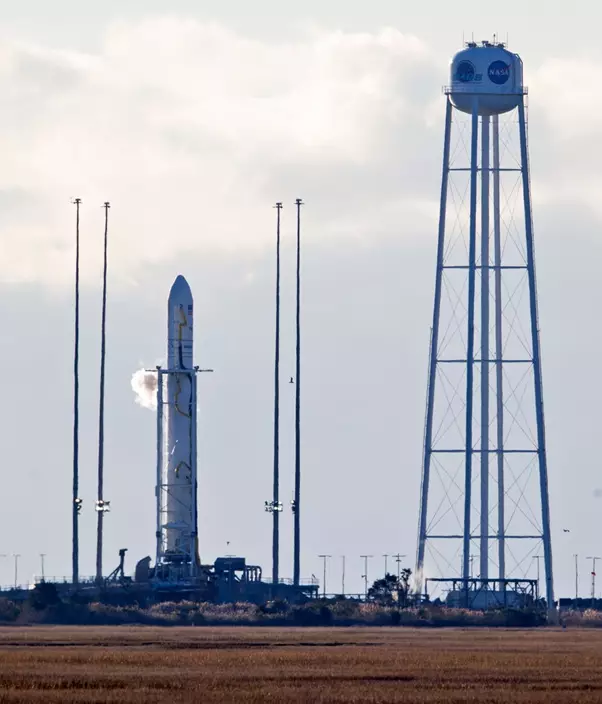
Orbital ATK's Antares rocket sits on the 0A launch pad moments before a scheduled launch at the NASA Wallops Island flight facility in Wallops Island, Va., Saturday, Nov. 11, 2017. The launch of the rocket which is carrying cargo to the International Space Station was postponed due to aircraft in the area. (AP Photo/Steve Helber)
Orbital ATK named the capsule after the last man to walk on the moon, Apollo 17's Gene Cernan, who died in January. During the final minutes of the countdown, a launch controller paid tribute to Cernan as well as J.R. Thompson, a high-ranking NASA and Orbital ATK official who died last week.
The capsule will remain at the space station until the beginning of December, when it's cut loose for a test of close proximity flying, a series of mini satellite deployments and, lastly, a fiery re-entry with a load of trash.
SpaceX is NASA's other prime supplier. It's next station delivery is next month.
MOSCOW (AP) — Russia on Thursday successfully test-launched a new heavy-lift rocket from its Far Eastern space complex, a lift-off that comes after two aborted attempts earlier this week.
The first attempt to launch the Angara-A5 rocket from the Vostochny spaceport on Tuesday was canceled about two minutes before the scheduled liftoff due to a failure of the pressurization system of the oxidizer tank in the central block of the rocket.
The second attempted launch Wednesday was also aborted by the automatic safety system, which registered a flaw in the engine start control mechanism, said Yuri Borisov, head of Russia’s state-controlled space corporation Roscosmos. He added that the failure was most likely rooted in a programming error.
Thursday's launch is the fourth for the Angara-A5, a heavy-lift version of the new Angara family of rockets that has been developed to replace the Soviet-designed Proton rockets.
The previous three launches were carried out from the Plesetsk launchpad in northwestern Russia.
After the 1991 breakup of the Soviet Union, Russia leased the Baikonur Cosmodrome from Kazakhstan and continued to use it for most of its space launches. The agreement with Kazakhstan allows Russia to keep leasing Baikonur for $115 million a year through 2050.
While Roscosmos has continued to rely on Baikonur, Russian authorities have developed Vostochny as the facility of choice for Angara launches. The construction of the new spaceport has dragged on for longer than planned and it has seen only limited use so far.
The development of the Angara-A-5, which is set to be the main launch vehicle for Russia’s prospective lunar research program, has also faced repeated delays and dragged on years behind schedule.
Like the Soviet-designed Proton it’s set to replace, the new rocket is intended to launch intelligence and communication satellites to geostationary orbits.

In this grab taken from video released by Roscosmos space corporation on Thursday, April 11, 2024 an Angara-A5 rocket lifts off from Vostochny space launch facility outside the city of Tsiolkovsky, about 200 kilometers (125 miles) from the city of Blagoveshchensk in the far eastern Amur region, Russia. Russia on Thursday successfully test-launched a new heavy-lift rocket from its Far Eastern space complex, a lift-off that comes after two aborted attempts earlier in the week. (Roscosmos Space Corporation via AP)

In this grab taken from video released by the Roscosmos space corporation on Thursday, April 11, 2024 an Angara-A5 rocket lifts off from Vostochny space launch facility outside the city of Tsiolkovsky, about 200 kilometers (125 miles) from the city of Blagoveshchensk in the far eastern Amur region, Russia. Russia on Thursday successfully test-launched a new heavy-lift rocket from its Far Eastern space complex, a lift-off that comes after two aborted attempts earlier this week. (Roscosmos Space Corporation via AP)

In this grab taken from video released by Roscosmos space corporation on Thursday, April 11, 2024 an Angara-A5 rocket lifts off from Vostochny space launch facility outside the city of Tsiolkovsky, about 200 kilometers (125 miles) from the city of Blagoveshchensk in the far eastern Amur region, Russia. Russia on Thursday successfully test-launched a new heavy-lift rocket from its Far Eastern space complex, a lift-off that comes after two aborted attempts earlier in themweek. (Roscosmos Space Corporation via AP)











